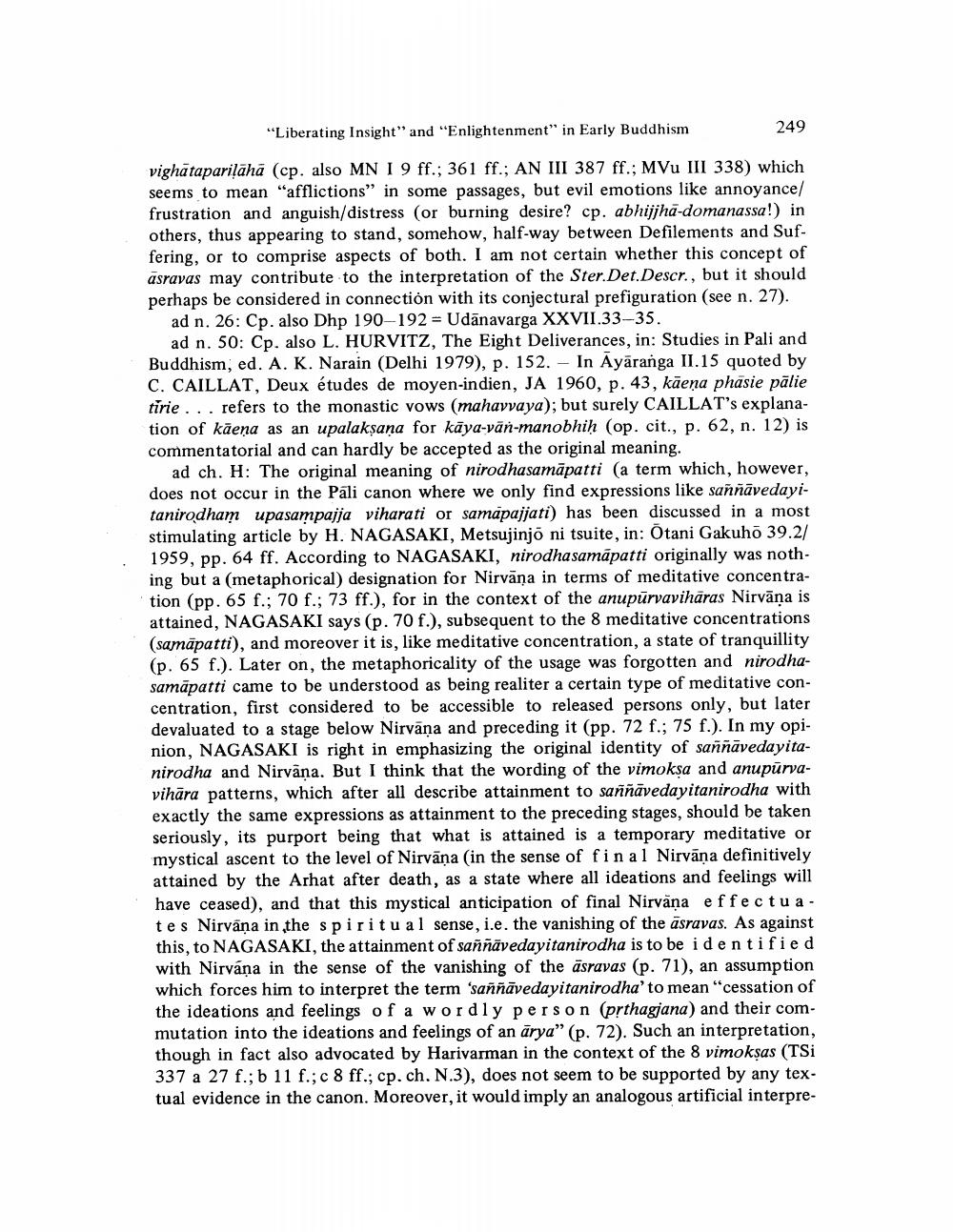________________
"Liberating Insight" and "Enlightenment" in Early Buddhism
249
vighātaparilāhā (cp. also MN I 9 ff.; 361 ff.; AN III 387 ff.; MVu III 338) which seems to mean "afflictions” in some passages, but evil emotions like annoyance/ frustration and anguish/distress (or burning desire? cp. abhijjhā-domanassa!) in others, thus appearing to stand, somehow, half-way between Defilements and Suffering, or to comprise aspects of both. I am not certain whether this concept of asravas may contribute to the interpretation of the Ster.Det.Descr., but it should perhaps be considered in connection with its conjectural prefiguration (see n. 27).
ad n. 26: Cp. also Dhp 190-192 = Udanavarga XXVII.33-35.
ad n. 50: Cp. also L. HURVITZ, The Eight Deliverances, in: Studies in Pali and Buddhism, ed. A. K. Narain (Delhi 1979), p. 152. – In Ayāranga II.15 quoted by C. CAILLAT, Deux études de moyen-indien, JA 1960, p. 43, kāeņa phasie pālie tirie ... refers to the monastic vows (mahavvaya); but surely CAILLAT's explanation of kāena as an upalaksana for kāya-van-manobhiḥ (op. cit., p. 62, n. 12) is commentatorial and can hardly be accepted as the original meaning.
ad ch. H: The original meaning of nirodhasamāpatti (a term which, however, does not occur in the Pali canon where we only find expressions like saññāvedayitanirodham upasampajja viharati or samapajjati) has been discussed in a most stimulating article by H. NAGASAKI, Metsujinjo ni tsuite, in: Otani Gakuho 39.2/ 1959, pp. 64 ff. According to NAGASAKI, nirodhasamāpatti originally was nothing but a (metaphorical) designation for Nirvana in terms of meditative concentration (pp. 65 f.; 70 f.; 73 ff.), for in the context of the anupūrvavihāras Nirvāṇa is attained, NAGASAKI says (p. 70 f.), subsequent to the 8 meditative concentrations (samāpatti), and moreover it is, like meditative concentration, a state of tranquillity (p. 65 f.). Later on, the metaphoricality of the usage was forgotten and nirodhasamāpatti came to be understood as being realiter a certain type of meditative concentration, first considered to be accessible to released persons only, but later devaluated to a stage below Nirvana and preceding it (pp. 72 f.; 75 f.). In my opinion, NAGASAKI is right in emphasizing the original identity of sannāvedayitanirodha and Nirvana. But I think that the wording of the vimoksa and anupūrvavihāra patterns, which after all describe attainment to saññāvedayitanirodha with exactly the same expressions as attainment to the preceding stages, should be taken seriously, its purport being that what is attained is a temporary meditative or mystical ascent to the level of Nirvana (in the sense of final Nirvāna definitively attained by the Arhat after death, as a state where all ideations and feelings will have ceased), and that this mystical anticipation of final Nirvana effectuates Nirvana in the spiritual sense, i.e. the vanishing of the asravas. As against this, to NAGASAKI, the attainment of saññāvedayitanirodha is to be identified with Nirvana in the sense of the vanishing of the asravas (p. 71), an assumption which forces him to interpret the term 'saññāvedayitanirodha' to mean "cessation of the ideations and feelings of a wordly person (prthagjana) and their commutation into the ideations and feelings of an ārya" (p. 72). Such an interpretation, though in fact also advocated by Harivarman in the context of the 8 vimokşas (TSI 337 a 27 f.;b 11 f.;c 8 ff.; cp.ch. N.3), does not seem to be supported by any textual evidence in the canon. Moreover, it would imply an analogous artificial interpre




